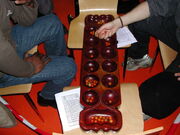
Close up of a sowing move
Moves in mancala games consist of distributing (or spreading) stones into succeeding pits. This is so typical that mancala games are also known as sowing games. Each move consists of one or several laps. Games which have just single laps are called single lap games, while games with several laps (also called relay sowing) are known as multiple lap games.
A lap consists of picking up all the seeds of a pit and then sowing them, one by one, into the following pits:
The seeds are picked up from the only occupied hole ...
and then are sown counterclockwise.
Usually mancala games have a predetermined sense of sowing. The following examples are all counterclockwise sowings.
Single Lap
There are two ways of single lap sowing. In most games the first seed is placed in the hole next to the emptied one:
The seeds picked up from the last hole of the bottom row ...
and then are sown.
In a few games (i.e. Oware), the initial hole is skipped if there are enough seeds to make a full round:
The seeds of the most loaded hole are picked uo ...
and are sown, skipping the original hole.
However, in almost all single lap games the initial hole is not skipped (i.e. Um ed-Dyar, Adji-boto and Vai Lung Thlan.
Starting in the Initial Hole
In some games (e.g. Toguz Kumalak), the first seed is put into the hole, which was just emptied:
South plays from the 7th hole.
This is the resulting position.
Traditional single-lap games are mostly played in West Africa, Arabic countries, Central Asia, the Caribbean and South America. Most modern mancala games also have single-lap sowing.
Multiple Lap
Multi-lap moves don't end after the first sowing, but continues, usually with the contents of the last hole into which a seed was dropped until the lap ends in an empty hole.
The first lap begins with the white pit.
The board after the first lap.
After the second lap.
After the third lap.
The fourth lap ends the move because the last seed (the black one) fell into an empty pit.
In some four-row games, the move continues with the captured seeds (e.g. Omweso, Hus, Bao), whilst in others the move ends (e.g. Mefuvha, Hawalis).
In many two-row games, the move also ends after a capture (e.g. Ba-awa, Aw-li On-nam Ot-tjin), but there is at least one game in which the player gets a bonus move after a capture gives (Hoyito). In many others the capture is made, when the last seed fell into an empty hole (e.g. Sungka, Congkak).
Some people call this kind of multiple lap sowing African style laps.
Pussa Kanawa
In pussa kanawa moves, a new lap is started with the contents of the hole, which follows next to the last hole filled. The move ends when the last stone falls into a hole just prior to an empty hole:
Sowing starts from the white pit.
The board after the first lap.
After the second lap.
The move ends ends after the third lap because the next hole (black) is empty.
This kind of sowing is also known Indian style sowing, although it is called pussa kanawa by mancala experts. Most pussa kanawa games are played in India, Sri Lanka, Yunnan (China), Myanmar and Vietnam. A few games have been also reported from isolated pockets in Africa (e.g. Kisolo, Congo, and Bosh, Somalia).
Multiple-lap games are prevalent in central, eastern and southern regions of Africa, in India and south-eastern Asia. In West Africa, the Caribbean and South America they occur together with single-lap games.
Mancala games with one or two rows are played with single or multiple laps, while mancala games with three or more rows are all multi-lap games.
Fractured Laps
Some two-dimensional sowing games have a mancala-like move mechanism, in which a track is left on the board, which is formed over several moves or even the whole game. The mechanism was invented by Bill Taylor, a mathematician from New Zealand, for gis game Slime Trail in 1992.
Differences between Single Lap and Multiple Lap Games
- Multiple lap moves effect more holes so that the resulting board position is more difficult to predict. Multi-lap games tend to have less "clarity" as defined by J. Mark Thompson.
- Multiple lap moves can lead to never-ending moves cycling around the board for ever.
- When single and multiple lap games (Western Africa and the Caribbean) are known in the same area, the single-lap games are often played by adult men and the multiple lap games by children and women.
- In all traditional single lap games and also in all pussa kanawa games except Kisolo, the seeds are sown along one circular path. In multiple lap games, there can be one or two circles.
See also
References
- Dos Santos, C. J.
- Jogos africanos e a educação matemática: Semeando com a família Mancala. Universidade Estudial de Maringá, Maringá (Brazil) 2008.
- Eagle, V. A.
- On a Phylogenetic Classification of Mancala Games, with some Newly Recorded Games from the Southern Silk Road", Yunnan Province, China. In: Board Games Studies 1999 (1); 51-68.
- Murray, H. J. R.
- A History of Board-Games Other Than Chess. Oxford (England) 1951.
- Russ, L.
- The Complete Mancala Games Book: How to Play the World's Oldest Board Games. Marlowe & Company, New York (USA) 2000.
- Thompson, J. M.
- Defining the Abstract. In: The Games Journal: A Magazine about Boardgames July 2000.
- Townshend, P.
- Mankala in Eastern and Southern Africa: A Distributional Analysis. In: Azania: Journal of the British Institute in Eastern Africa 1979; 14: 108-138.
Copyright
© Wikimanqala.
By: Ralf Gering & Víktor Bautista i Roca.
Under the CC by-sa 2.5.















